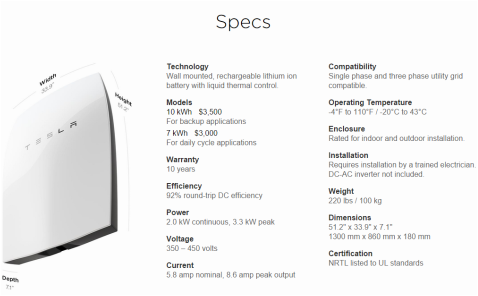
10kWh = 833Ah @ 12v
Powerwall is = to the storage capacity of roughly 21 car batteries or 8 deep cycle batteries.
Most large batteries in use today are the lead-acid type. These are heavy, messy, can leak toxic gasses or acid and have an estimated battery life of 5 years. The Powerwall is a Lithium ion battery (type used in many digital cameras) which are lighter, safer and last much longer. Tesla's Powerwall includes a 10 year warranty with an optional 10 year extension! So the service life of the Powerwall battery is 2 to 4 times longer than a lead-acid battery.
Car batteries weigh around 40 pounds and provide 40Ah of storage; around 1 lb per Ah. Making a car battery bank with the Powerwall storage capacity would weigh around 840 lbs (381kg) compared with Tesla's Powerwall weight of 220lb (100kg).
Powerwall Specs and grapics from Teslamotors.com
Why write about this on a travel blog? Well Elon Musk might have just revolutionized the energy storage market in the Marine and RV industry as well. Perhaps not many people have realized that yet. Putting something like this (or a modified version) in the yacht I fixed up or any vehicle/vessel intending to be energy self-sufficient for long term travel is the way of the future! My rough estimates put this around a third of the cost compared to what's available now; including lithium ion batteries for the home or marine industry.
Note: This is a simplified look at the Powerwall in terms of battery storage capacity. The Powerwall is rated at 350-450 Volts @ 5.8 amps DC and therefore must be inverted and/or stepped down before use with most electronics.




 RSS Feed
RSS Feed
